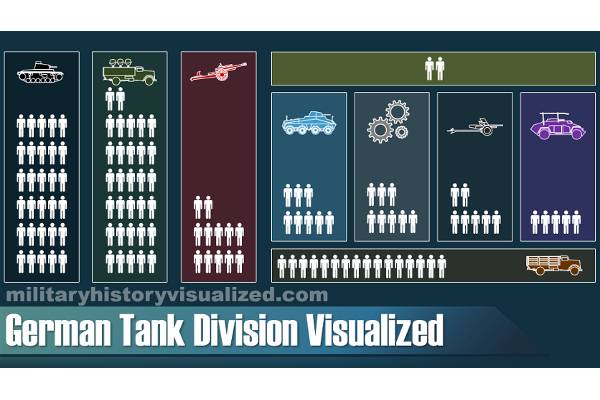Intro
In total the United States raised 16 armored division in World War 2. In September 1943 fourteen of those were reorganized, these are sometimes called the „light“ armored divisions, although this name is a bit misleading, because the main difference was in size and not the equipped tanks. So let’s take a closer look. (Source: Stanton, Shelby L.: Order of Battle US Army World War II, p. 15-20)
Numbers
Such a “light” division in total consisted of around:
11 000 men
54 M8 Armored Cars
54 M7 Priest Self-Propelled Artillery
460 2 ½ Trucks,
450 M3 Halftracks
465 .30 cal Machine guns
404 .50 cal Machine guns
30 57mm anti tank guns
77 Light Tanks like the M5A1 Stuart(, which were later on replaced by the M24 Chaffee)
168 Medium M4 Sherman Tanks
18 Medium Tanks with 105 mm Howitzers
30 M32 Tank Recovery Vehicles
449 Jeeps
Organization
The structure of the September 1943 divisions was without regiments, hence the largest sub-unit is the battalion. The division consisted of 1 Signal Company, 3 Tank Battalions, 3 Armored Infantry Battalions, the divisional Artillery consisting of 3 armored field artillery battalions, 1 Mechanized Cavalry Recon Squadron, 1 Armored Division Trains with a Medical Battalion and an Armored Maintenance Battalion. And 1 Armored Engineer Battalion.
Now every of these Tank Battalions consisted of three Medium Tank Companies and One light Tank Company. Let’s take a closer look.
The Medium Tank Company consisted of an HQ section and 3 Medium Tank Platoons. The HQ Section consisted of two M4 Shermans, one M4 with a 105 howitzer and a jeep. Each of the Medium Tank platoons consisted of 5 M4 Shermans.
The Light Company was quite similar. It consisted also of one HQ section and three platoons. The HQ section consisted of two M5A1 Stuart tanks and one jeep. Each Platoon consisted of 5 tanks. Note that from late 1944 onwards the Stuarts were replaced by the M24 Chaffee Light tank. (Source: Stanton, Shelby L.: Order of Battle US Army World War II, p. 19)
Sources
Books
Stanton, Shelby L.: Order of Battle US Army World War II (amazon.com affiliate link)
| amazon.com | amazon.co.uk | amazon.ca | amazon.de |
Disclaimer amazon.com
Bernhard Kast is a participant in the Amazon Services LLC Associates Program, an affiliate advertising program designed to provide a means for sites to earn advertising fees by advertising and linking to amazon.com.
Disclaimer amazon.co.uk
Bernhard Kast is a participant in the Amazon EU Associates Programme, an affiliate advertising programme designed to provide a means for sites to earn advertising fees by advertising and linking to Amazon.co.uk.
Disclaimer amazon.ca
Bernhard Kast is a participant in the Amazon.com.ca, Inc. Associates Program, an affiliate advertising program designed to provide a means for sites to earn advertising fees by advertising and linking to Amazon.ca.
Disclaimer amazon.de
Bernhard Kast ist Teilnehmer des Partnerprogramms von Amazon Europe S.à.r.l. und Partner des Werbeprogramms, das zur Bereitstellung eines Mediums für Websites konzipiert wurde, mittels dessen durch die Platzierung von Werbeanzeigen und Links zu amazon.de Werbekostenerstattung verdient werden können.

